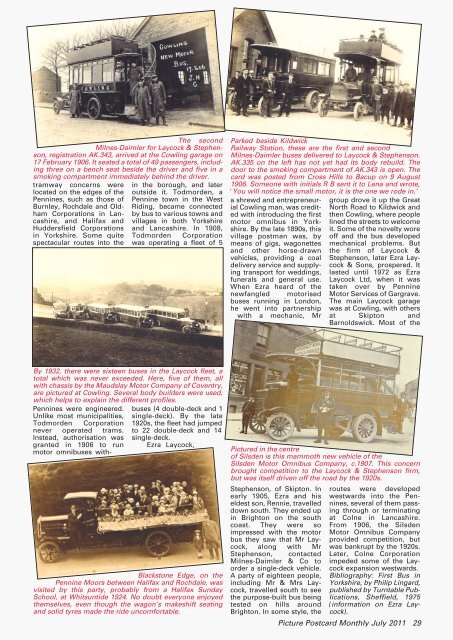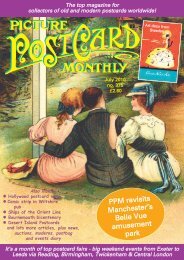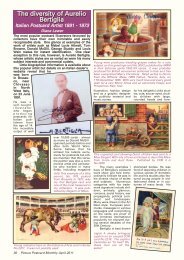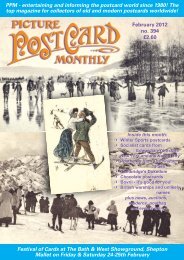Create successful ePaper yourself
Turn your PDF publications into a flip-book with our unique Google optimized e-Paper software.
The second<br />
Milnes-Daimler for Laycock & Stephenson,<br />
registration AK.343, arrived at the Cowling garage on<br />
17 February 1906. It seated a total of 49 passengers, including<br />
three on a bench seat beside the driver and five in a<br />
smoking compartment immediately behind the driver.<br />
tramway concerns were<br />
located on the edges of the<br />
Pennines, such as those of<br />
Burnley, Rochdale and Oldham<br />
Corporations in Lancashire,<br />
and Halifax and<br />
Huddersfield Corporations<br />
in Yorkshire. Some quite<br />
spectacular routes into the<br />
Pennines were engineered.<br />
Unlike most municipalities,<br />
Todmorden Corporation<br />
never operated trams.<br />
Instead, authorisation was<br />
granted in 1906 to run<br />
motor omnibuses with-<br />
in the borough, and later<br />
outside it. Todmorden, a<br />
Pennine town in the West<br />
Riding, became connected<br />
by bus to various towns and<br />
villages in both Yorkshire<br />
and Lancashire. In 1908,<br />
Todmorden Corporation<br />
was operating a fleet of 5<br />
By 1932, there were sixteen buses in the Laycock fleet, a<br />
total which was never exceeded. Here, five of them, all<br />
with chassis by the Maudslay Motor Company of Coventry,<br />
are pictured at Cowling. Several body builders were used,<br />
which helps to explain the different profiles.<br />
buses (4 double-deck and 1<br />
single-deck). By the late<br />
1920s, the fleet had jumped<br />
to 22 double-deck and 14<br />
single-deck.<br />
Ezra Laycock,<br />
Blackstone Edge, on the<br />
Pennine Moors between Halifax and Rochdale, was<br />
visited by this party, probably from a Halifax Sunday<br />
School, at Whitsuntide 1924. No doubt everyone enjoyed<br />
themselves, even though the wagon’s makeshift seating<br />
and solid tyres made the ride uncomfortable.<br />
Parked beside Kildwick<br />
Railway Station, these are the first and second<br />
Milnes-Daimler buses delivered to Laycock & Stephenson.<br />
AK.335 on the left has not yet had its body rebuild. The<br />
door to the smoking compartment of AK.343 is open. The<br />
card was posted from Cross Hills to Bacup on 9 August<br />
1906. Someone with initials R B sent it to Lena and wrote,<br />
‘You will notice the small motor, it is the one we rode in.’<br />
a shrewd and entrepreneurial<br />
Cowling man, was credited<br />
with introducing the first<br />
motor omnibus in Yorkshire.<br />
By the late 1890s, this<br />
village postman was, by<br />
means of gigs, wagonettes<br />
and other horse-drawn<br />
vehicles, providing a coal<br />
delivery service and supplying<br />
transport for weddings,<br />
funerals and general use.<br />
When Ezra heard of the<br />
newfangled motorised<br />
buses running in London,<br />
he went into partnership<br />
with a mechanic, Mr<br />
Stephenson, of Skipton. In<br />
early 1905, Ezra and his<br />
eldest son, Rennie, travelled<br />
down south. They ended up<br />
in Brighton on the south<br />
coast. They were so<br />
impressed with the motor<br />
bus they saw that Mr Laycock,<br />
along with Mr<br />
Stephenson, contacted<br />
Milnes-Daimler & Co to<br />
order a single-deck vehicle.<br />
A party of eighteen people,<br />
including Mr & Mrs Laycock,<br />
travelled south to see<br />
the purpose-built bus being<br />
tested on hills around<br />
Brighton. In some style, the<br />
group drove it up the Great<br />
North Road to Kildwick and<br />
then Cowling, where people<br />
lined the streets to welcome<br />
it. Some of the novelty wore<br />
off and the bus developed<br />
mechanical problems. But<br />
the firm of Laycock &<br />
Stephenson, later Ezra Laycock<br />
& Sons, prospered. It<br />
lasted until 1972 as Ezra<br />
Laycock Ltd, when it was<br />
taken over by Pennine<br />
Motor Services of Gargrave.<br />
The main Laycock garage<br />
was at Cowling, with others<br />
at Skipton and<br />
Barnoldswick. Most of the<br />
<strong>Picture</strong>d in the centre<br />
of Silsden is this mammoth new vehicle of the<br />
Silsden Motor Omnibus Company, c.1907. This concern<br />
brought competition to the Laycock & Stephenson firm,<br />
but was itself driven off the road by the 1920s.<br />
routes were developed<br />
westwards into the Pennines,<br />
several of them passing<br />
through or terminating<br />
at Colne in Lancashire.<br />
From 1906, the Silsden<br />
Motor Omnibus Company<br />
provided competition, but<br />
was bankrupt by the 1920s.<br />
Later, Colne Corporation<br />
impeded some of the Laycock<br />
expansion westwards.<br />
Bibliography: First Bus in<br />
Yorkshire, by Philip Lingard,<br />
published by Turntable Publications,<br />
Sheffield, 1975<br />
(information on Ezra Laycock).<br />
<strong>Picture</strong> <strong>Postcard</strong> <strong>Monthly</strong> <strong>Jul</strong>y 20<strong>11</strong> 29








